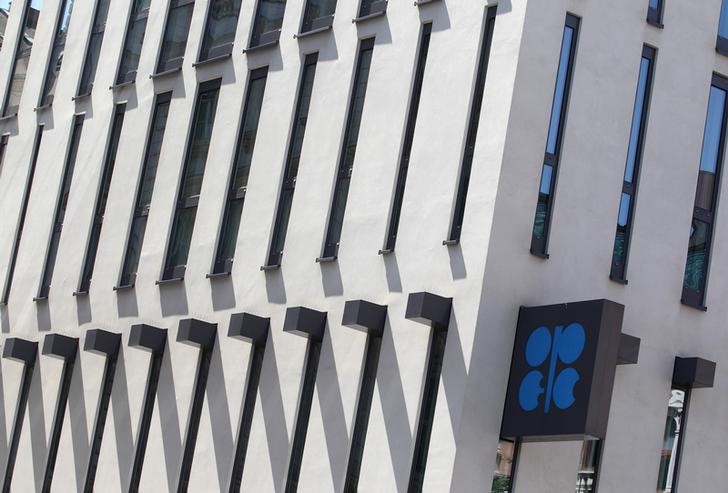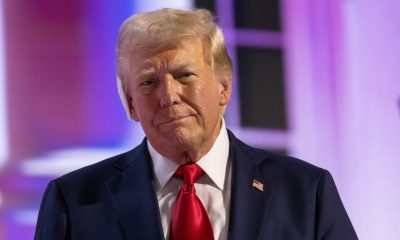Investing
Analysis-Inside OPEC+, Saudi ‘lollipop’ oil cut was a surprise too

© Reuters. FILE PHOTO: A 3D printed oil pump jack is seen in front of displayed Opec logo in this illustration picture, April 14, 2020. REUTERS/Dado Ruvic/Illustration
By Dmitry Zhdannikov, Ahmad Ghaddar and Alex Lawler
LONDON (Reuters) – Saudi Arabia kept under wraps its plan to make a deep cut to its own oil output during a weekend of OPEC+ talks in Vienna, several OPEC+ sources told Reuters, with some member states only learning about the reduction from the final news conference.
Saudi Arabia is the top OPEC producer and the member with the most flexibility to raise or cut output, giving the kingdom unrivalled influence over the oil market – although the impact on oil prices since announcing its plans has been modest so far.
The Saudi Energy Minister Prince Abdulaziz bin Salman has previously used the power of surprise in managing oil markets, where prices have come under pressure due to concerns about the weakness of the global economy and its impact on demand.
Days before the OPEC+ meeting, Prince Abdulaziz said he would inflict more pain on short sellers – those who bet that oil prices will fall – and told them to watch out. He announced the output cut after the meeting, calling it a “Saudi lollipop”.
Four OPEC+ sources, who were among their countries’ delegations involved in policy talks, said they only heard details of the Saudi cut at the Sunday evening news conference – and that the idea of a cut didn’t come up during a weekend of discussions on a broader deal to limit supply into 2024.
“No information on the additional cut was shared prior to the press conference,” one of the four sources said. “It was a surprise one, once again.”
Saudi Arabia said it would cut output in July by 10% or 1 million barrels per day (bpd) to 9 million bpd and may extend cuts further if needed. Meanwhile, OPEC+ agreed to extend cuts into 2024 but didn’t commit to any fresh cuts in 2023.
OPEC+, which groups the Organization of the Petroleum Exporting Countries and allies led by Russia, pumps around 40% of the world’s crude.
As well as the Saudi cut, OPEC+ lowered its collective production target for 2024 and the nine participating countries extended the April voluntary cuts to the end of 2024.
The United Arab Emirates secured a higher output quota that it had long been seeking – an issue that has caused tension between the group and Abu Dhabi, which has been increasing its output capacity.
The Saudi Energy Ministry and OPEC’s Vienna headquarters did not respond to requests for comment.
‘CAN’T PUSH THE OTHERS’
In the days leading up to the June 4 meeting, two other OPEC+ sources said there was an idea for more cuts by OPEC+ states, although this did not proceed to advanced discussions in Vienna.
Saudi Arabia, other OPEC+ sources said, recognised it would be difficult to secure cuts from others such as the UAE and Russia, which according to sources in the days before the meeting was reluctant to cut output further.
“The Saudis were cognizant this time they could not push the others,” an OPEC+ source said. “The UAE are happy with the new quota and it is a big relief for the Saudis.”
Still, Saudi Arabia did manage to persuade other members of OPEC+ that have been unable to produce at required levels due to lack of investment in capacity – notably Nigeria and Angola – to accept lower production targets for 2024 after long meetings.
Prince Abdulaziz told Al Arabiya after the meeting the group was tired of giving quotas to countries that were unable to produce them and that Russia needed to be transparent about its output and exports levels.
OPEC+ sources said the new targets for Angola and Nigeria were still higher than the countries can realistically pump, which means they do not have to perform real cuts.
Russia, whose exports have stayed strong despite Western sanctions, also avoided having to make a further reduction.
It is unclear if Saudi Arabia hinted about its possible voluntary cut to some officials in Russia or the African producers to help persuade them to agree a broader deal.
Nonetheless, all those producers stand to benefit if they can keep output the same or pump a bit more, especially if the Saudi cut boosts prices.
The Saudi cut could also give the kingdom more leverage in coming months to pressure countries that are not cutting output and yet benefit from others’ cuts, one OPEC+ source said.
“To avoid free rider behaviour, Saudi Arabia could threaten to put 1 million bpd back on the market within 30 days, which would lead to a drop in prices,” another OPEC+ source said. He did not name which countries this might be directed at.
So far, oil prices have risen slightly following the Saudi plan. is trading higher than $77 on Thursday, up from Friday’s close just above $76.
“Saudi cuts are playing second fiddle to worries about the state of the global economy,” said Stephen Brennock of oil broker PVM, although he added the Saudi cut could widen a supply deficit in July.
“Accordingly, it will take a brave man to bet against an eventual uptick in prices.”
Read the full article here

-

 Side Hustles6 days ago
Side Hustles6 days agoYou Might Not Get a New Job in 2025 Without These 2 Skill Sets
-

 Investing5 days ago
Investing5 days agoThe Marketing Mistake I Turned Into $1 Million in New Business
-

 Side Hustles5 days ago
Side Hustles5 days ago9 Questions Leaders Must Ask to End Employee Burnout
-

 Side Hustles4 days ago
Side Hustles4 days agoA Simple Four-Step Approach to Mastering Sales Psychology
-

 Side Hustles4 days ago
Side Hustles4 days agoHere Are the Cities Where Your Paycheck Goes the Farthest
-

 Investing6 days ago
Investing6 days agoSamsung and Google partner for augmented reality glasses By Investing.com
-

 Passive Income5 days ago
Passive Income5 days agoHow Your First Job Can Prepare You for Entrepreneurial Success
-

 Make Money6 days ago
Make Money6 days agoTrump’s Plan to Collect Foreign Revenue: 6 Key Details to Know


















